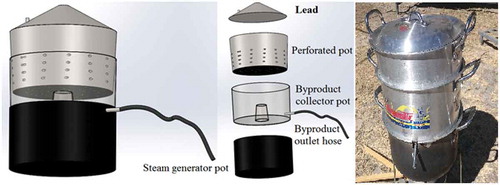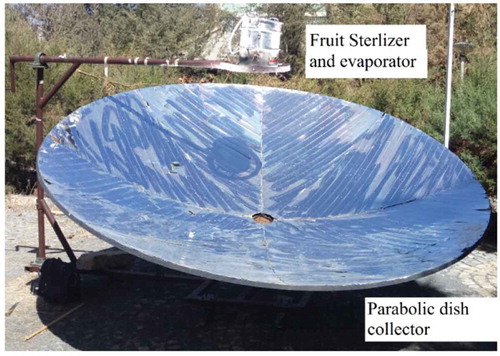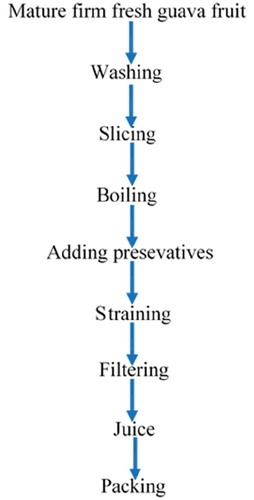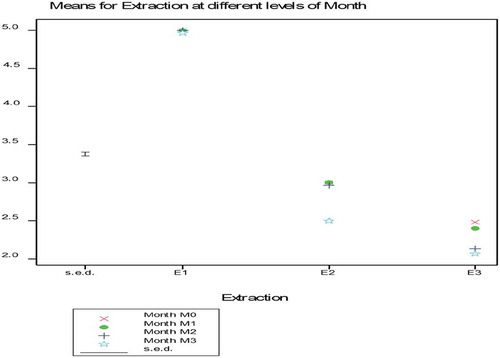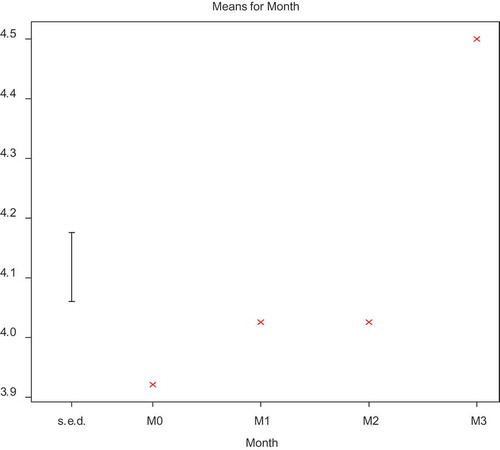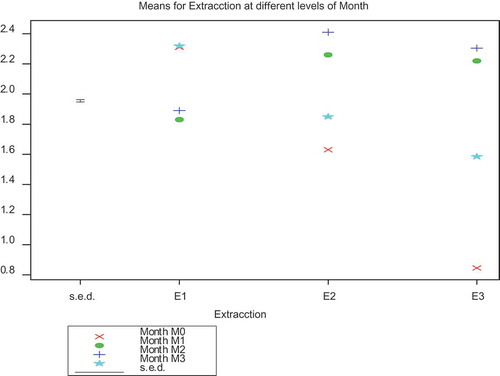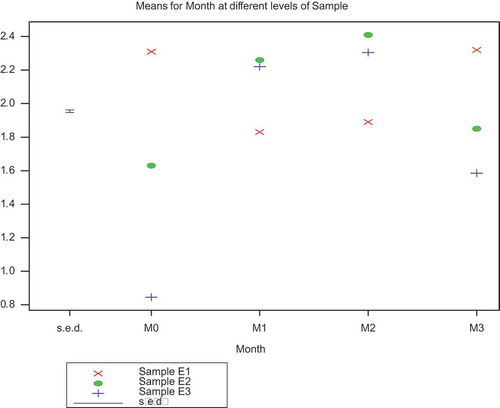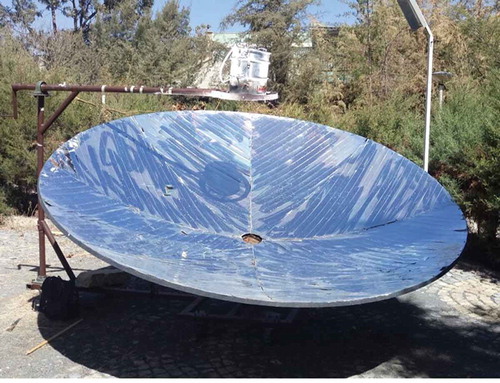Abstract
This paper deals with PHL management of Guava fruit through small-scale juice processing in rural areas that have no access of modern energy. Guava trees cover large areas in Tigray region of Ethiopia, however, during the harvest period the consumption and yield of the fruit is not in balance. Consequently, considerable amount of the fruit spoiled in the field. In addition, during this period the market price of the fruit is very low and discourage farmers to collect the fruit as its market price could not cover the labor cost. On the other hand, the fruit is not available out of the yield season. This study has demonstrated fruit processing using locally developed solar energy technologies to improve PHL management of fruits and vegetables. The technology has sized in view of smallholding farmer’s production capacity with an average power of 6kW at an average solar insulation of 800 W/m2 that boils 5 l of water in 5 min. During the experiment, uniformly sliced fruits were boiled using the solar boiler for half an hour to make it sterilized and soft. The boiled fruit was mixed with preservatives, homogenized, filtered and hot-filled into a glass bottle to avoid air traps. The juice examined regularly in 30, 60 and 90 days for its PH, TSS and total microbial load. The results have shown the average total bacteria counts of the juices is below the maximum allowable limit in foods for consumption. Accordingly, the technology would enable smallholding farmers to start equitable agroprocessing.
PUBLIC INTEREST STATEMENT
Agriculture is the main stay of many developing countries and it needs to transform in a way that enables value chain improvement in the sector. In addition, the sector has the highest potential to create a job in both rural and urban. However, many developing countries including Ethiopia has the lowest energy access in the rural, which is a threat to modernize the sector. This research demonstrated how locally developed solar thermal technology could use to start small-scale juice processing activities in remote areas. This processing activity would involve many youngsters in the rural and urban who are disadvantaged or looking for job. This research will help farmers to reduce their post-harvest loss by improving the shelf life of fruits and vegetable such as tomato. This would pave a way for farmers to enter into value addition and improve their overall livelihood development.
Competing Interests
The authors declares no competing interests.
1. Introduction
Guava is an exquisite, nutritionally valuable and remunerative fruit of tropical and subtropical regions with high nutritive value and popular processed products. Guava is highly nutritious and a good source of calcium, iron, and phosphorus. Its vitamin C content is 2–5 times that of citrus (Encyclopedia of Food and Health, Citation2016). Guava could be processed into a number of products such as juice, jam, and jelly to extend its availability throughout the year. Guavas fruits are rich in vitamins A and C in the pericarp, omega-3 and −6 polyunsaturated fatty acids in the seeds, high levels of dietary fiber and have lycopene, a carotenoid with antioxidant properties. Guava is commonly cultivated in many tropical and subtropical countries (Pommer & Katia, Citation2008). A single guava fruit weighing 160–170 g contains over four times more of vitamin C compared to a single orange (220–230 mg/100g) and also has sufficient amount of dietetic minerals, potassium, magnesium and low-calorie profile of essential nutrients (Shishir, Taip, Aziz, & Talib, Citation2014). Individual guava fruit without seed (90 g) gives 46 kilocalories energy, has 78% water, 5-g nutritional fiber, 1g fat, 11g carbohydrate, 1 g protein, 18 mg calcium, 256 mg potassium, 9 mg magnesium, 23 mg Phosphorus, 71 RE vitamin A, 165 mg vitamin C and 1 mg of niacin and vitamin E each (Murdock, Citation2002). Its seeds also contain protein, which is used in the guava seed meal. The essential amino acid profile of guava seed protein isolate, except for lysine contents, is higher than that proposed in the FAO/WHO pattern for adult human beings (Nicanor, Moreno, Ayala, & Ortiz, Citation2001). It is a seasonal fruit with the harvesting period from mid of October to the end of January and it is very much delicate. On average it is consumed fresh as a dessert fruit with sweet and refreshing flavor. The short shelf life, six to 8 days, confines the availability of fresh guava fruit. As a result, guava cultivators fail to get attractive income and virtually 20–25% of the produce left as devastate (Moon et al., Citation2018). Different processed products of guava such as jam, jelly, cheese, canned fruit segments, ready to serve drink, nectar, squash, dried powder, ice cream, highly concentrated puree, candy, toffees, syrup, juice and concentrates (Almulaiky et al., Citation2018) can help to minimize post-harvest losses, increase economic and nutrition access of the society. Guava is generally jelly and rich in pectin, 1% to 2.2%, that makes it suitable to produce a high-quality jelly bar. The Guava jelly bar can attract the attention of food manufacturers because of its high vitamin C content, fresh flavour, and delicacy. Pink fleshed cultivars have low vitamin C content than white-fleshed ones; because of this it is important to select white-fleshed cultivars to produce guava jelly bar. Citric acid as a preservative increases the shelf life of guava jelly bar (Giovenzana, Beghi, Civelli, & Guidetti, Citation2015).
In developing countries such as Ethiopia, agriculture plays a significant role of the economy. However, the agriculture sector remained traditional with low productivity of smallholding farmers. In this view, any technological intervention would contribute in improving the sector. In this view, juice processing will improve the postharvest loss and shelf life of some fruits. This process requires both thermal and electrical energy. However, it is very difficult to get these energies in un-electrified villages of many developing countries including Ethiopia. Farmers who live in these places live naturally and sell their agricultural products without major value addition.
Guava is highly produced in different parts of Tigray but because of its short shelf life and very unattractive market price during the yield season, about half of the production is lost. In addition, market fluctuation made many farmers to leave their fruit on the farm and become the food of birds and the soil and some times in the market place. Guava processing is not a new technique in the developed world where accesses to electricity and access to modern transport is not a question of farmers. However, in the Ethiopian context the source of this fruit is mainly the smallholding farmers, which are found in a remote area where there is no modern energy supply and access to transportation instead the fruit has transported long distance on the back of a donkey and no option of cold chain. The interest of this research is to give hope and enable smallholding farmers to stay in the business of guava and other perishable fruit production by introducing suitable solar-driven pasteurization technologies that help farmers enter into small-scale agro processing. Thermal preservation is well-known traditional and most commonly used preservation technique in many food industries. Pasteurization and sterilization thermal techniques are used to increase the shelf life of products. Thermal processing requires the availability appropriate heat exchanger to generate steam and water and energy availability has imposed a challenge to the food industry (Lamo, Shahi, Singh, & Singh, Citation2019). The solar technology gives the energy to generate steam to sterilize and pasteurize the guava fruit in places where there is no electricity. The developed technology is versatile and it was used to process other fruits and vegetables such us mango, papaya and tomato. The research has tried to demonstrate how to minimize the post-harvest loss of guava fruits, create an agro-processing job, improve farmers income by selling processed juice with better price, assure sustainable supply in the urban and introduce value addition and improve export potential of guava producing farmers.
2. Method and materials
The methodology followed in this research includes:
Assessment of PHL: Detail field survey of postharvest losses of fruits/vegetables including but not limited to guava, mango, banana, papaya, orange and tomato
Prioritization of products that need immediate PHL intervention: Guava fruit has found to be the cheapest fruit during the yield season and with the highest PHL
Design of appropriate technology: equitable technology that can be used for processing and packing of fruit juice and vegetable juice has considered
Appropriate technology development: an integrated solar thermal and solar PV technology has developed
Experimentation of guava juice processing and packing: Experimental study on the processing and shelflife determination was conducted
This study is part of VLIR-UOS research initiative project that focuses on post-harvest loss (PHL) management through reverse engineering of solar energy technologies in Ethiopia. Intensive field survey of PHL on fruits and vegetables in general and Guava fruit, in particular, was conducted in Tigray region, Ethiopia. Accordingly, the authors come up with solar technology solutions to process juice, sause, and catchups. However, this paper only focuses on guava juice processing using the locally developed solar-driven technology suitable for smallholding farmers to prepare standard guava juice. To conduct this study, fresh matured guavas of similar maturation grades and ingredients were bought from the local market of Mekelle city. The raw materials were processed within 2 h of sample collection in the Food Science and Post-harvest Technology laboratory of Mekelle University. The components of the technology have given in Table .
Table 1. List of materials used in the research
2.1. Technology development
A locally solar thermal technology is developed to supply thermal energy to produce steam, which is used to sterilize, pasteurize and evaporate excess moisture content of the fruit. To facilitate this, a three-stage assembled pots have been used as a steam generator, byproduct collector and perforated pasteurization part as shown in Figure . The solar collector shown in Figure , is a thermal system where the solar radiation has focused into a point and converted into usable heat at the bottom pot called the receiver. The system gives an average power of about 6kW with average solar insulation of 800W/m2 with the capacity of boiling 5 l of water in 5 min. The concentrator is a 3 m diameter parabolic dish with movable linkage that enables users to load and unload their products off focus. Once the fruit has sterilized, boiled and evaporate the required water content it has passed to the next step of processing.
The softened fruit has homogenously mixed, squeezed and filtered by using a neat sieve and sealed. A total of 255 W peak power of Photovoltaic (PV) has used to run the juice mixer and sealer as shown in Figure . This technological package gives a holistic solution of juice processing in rural areas with no access to modern energy supply. The PV power is not only gives a running power to the mixer and sealer but also it gives light and mobile charging port to allow farmers to use mobile technology for communication.
2.2. Preparation of guava juice
Matured and uniform size guava fruits bought from the market were sorted on the basis of overall quality and cleaned with tap water to remove dirt, dust, pesticide residues and reducing microbial load. The washed fruits sliced into four parts to reduce its size with an ordinary knife. One kilogram of sliced guava fruit was added into a perforated pot to be sterilized and pasteurized by steam generated from 1 l of water in a solar steamer. The boiling process took half an hour to make the fruit soft and evaporate excess water. Later, 2 g of chemical preservative, citric acid was added, homogeneously mixed and strained by white fabric as shown in Figure . The strained juice has filtered by sieve, boiled and hot-filled into glass bottle and labeled as first extract. The remained pulp was weighed and mixed with water in a 1:1 ratio and boiled in the solar steamer for half an hour; strained, filtered and filled into a glass bottle. Using a similar procedure the pulp remained in the second extraction has processed to extract juice for the third time. Hot filling was completed in a clean and sterilized bottles and crown capped afterwards. The bottles were cooled at ambient temperature and then stored. The drink samples have examined at a regular interval of 30 days after the first date, i.e. 30, 60 and 90 days for total soluble solids and its total microbial load.
2.3. Analysis of guava drink
The analysis of the juice includes determining total soluble solids, PH value, and total microbial load. The total soluble solids of guava juice were determined by hand refractometer in accordance with Ruck (Lee, Lee, Kim, Patra, & Shin, Citation2019) method and expressed as °Brix and its PH has measured using a PH meter as describe in The Association of Official Agricultural Chemists (AOAC, Citation1995). Similarly, the determination of microbial load has followed the method of Rashed et al. (Simforian, Nonga, & Ndabikunze, Citation2015). Serial dilutions of samples were made up to 10−6 with sterile normal saline. Exactly 0.1 ml of each dilution was evenly spread on nutrient agar medium and incubated at 37°C for 24 h. Plates were screened for the presence of discrete colonies after the incubation period and the actual numbers of bacteria were estimated as log colony forming unit per ml (log CFU/ml). The load of specific microorganisms was determined by plating on selective media. Total coliform count (TCC), faecal coliform count (FCC), total staphylococcal count (TSC) and total fungal count (TFC) were performed in similar manner as described above using MacConkey agar, membrane faecal coliform (mFC) agar, Mannitol Salt Agar (MSA) and Sabroud dextrose agar (SDA) medium, respectively. In each case, plating was done in triplicates and counts taken from plates that had less than 300 colonies. Estimation of bacteria load was performed by standard method International Commission on Microbiology Specification for Food (ICMSF, Citation1998). In addition, statistical analysis of one-way ANOVA for the total plate counts of physicochemical parameters was performed using Graph pad prism version 7.00 for Windows.
3. Result and discussion
The effects of interaction of storage time and number of extraction on the Total Soluble Solids (TSS) of guava juice are shown in Figure & Table . Total soluble solids can be described as the amount of sugar and soluble mineral salts present in the juice. The initial TSS of the fresh juice was observed as 5 °Brix. The data on TSS revealed that there was a significant decrease on storage day increment as well as repetition of the juice extraction. There is no significant difference in TSS of the juice extracted first at day zero and after storing the juice for 1 month, 2 month and 3 month, which was 5 °Brix but the TSS continually decrease during the repetitive of extraction and storage period. This decrease could be due to water addition, during the consecutive extraction. As water is added, the solute concentration decreases, which leads to a decrease in TSS (Table ).
Table 2. Effect of interaction of storage time and number of extraction on the TSS of guava juice
Figure shows as the guava fruit is extracted the total soluble solids in the extract decreases because of the addition of water in the processing. The PH of the fresh juice was measured as 3.8, 3.9 and 4 of E1M0, E2M0 and E3M0, respectively, shown in Table . After storing them for one, two and three months the PH was observed to be 3.9, 3.97 and 4.2, respectively. This shows that the PH increased with an increase in number of extraction and storage time. The PH of the first extract juice at the first day (M0) was 3.8 but the PH of the same extract stored for one and 2 months shows a significant increase as shown in Figure , which is 6.6% increment under same storage condition. This decrease in acidity could be linked to the Phases of the processing such as extraction, storage, and heat treatment.
Table 3. Effect of interaction of storage and extraction time on the PH of guava juice
Similarly, all the extracted juice samples showed a viable bacterial count. The highest total bacteria load of 2.4 log CFU/ml was observed in the second extracted juice stored for 2 months (E2M2) while the lowest was recorded in the third extracted juice which was not stored. Because of the cooking temperature, the total microbial load of the extracts decreased as shown in Table . In all the samples, there was no faecal coliform found.
Table 4. Bacterial count of extracted juice
The microbial load of the guava juice extracts see Figure , were determined by checking the fungal and bacterial growth in the developed product for the wellbeing of the consumers. No fungal growth was detected in the products. Similar results were reported in foam-mat dried mango (Kadam, Wilson, & Kaur, Citation2010) which is climacteric fruit like guava. In the current study, the total bacterial count ranged from 0.845 log cfu/ml to 2.41 log cfu/ml for all the guava juice samples as shown in Figure . These counts were low and below the maximum allowable standard of 5 log cfu/ml (Biesta-Peters, Kinders, & de Boer, Citation2019). This observation is somewhat below the counts obtained in the work of Odu and Adeniji (Onuoha, Braide, & Orji et al., Citation2018) who reported high bacterial load ranging from 2.47 log cfu/ml to 4.95 log cfu/ml in some of the fruits under study. Therefore, the value-added products prepared from guava in this study may be adjudged safe as far as national and international standards of microbial safety are concerned (Alam & Islam, Citation2016; Araújo et al., Citation2017).
As the extraction increases the number of microorganisms decrease because of the repetitive heat application to extract the juice.
In the present study, no faecal coliform count was recorded in all the guava juices under study. This observation agreed with the work of Rashed et al. (Rashed et al., Citation2013) who reported no coliform and no fecal coliform on some strawberry, apple, orange and mango packed fruit juices studied and the works of Tasnim et al. (Odu & Adeniji, Citation2013), Oranusi et al. (Tasnim et al., Citation2010) and Odu and Adeniji (Iqbal et al., Citation2016) who recorded similar observation on different fruit juices including pineapple, orange and apple.
4. Conclusion
The study shows that the average total bacteria counts of the extracted guava juice samples examined are generally below the maximum allowable limit in foods for consumption (103cfu/g), which shows the average ranges obtained for the bacteria indicated as it will not pose a public health concern as they showed counts far below this limit. The low counts suggested less bacterial contamination potential of the juice. This is due to the high processing temperature (121ᵒC) used to sterilize, pasteurize and extract the juice. The locally developed solar thermal technologies would have a higher potential to create many jobs in the rural in small-scale juice processing that can address the growing demand, revolutionize the post-harvest management and value chain and reduce rural-urban immigration for the sake of economic sustainability. In return, sustainable scale able jobs would be created, reduced youth unemployment, accelerate sustainable rural-urbanization and will contribute to address the sustainable development goal.
Acknowledgements
The authors acknowledged, the funding of the research from VLIR’s Research Initiative Project 2016 on “Improving Drying and Storage Technologies with Reverse Engineering and Innovation for Minimizing Post Harvest Losses”.
Additional information
Funding
Notes on contributors
Asfafaw H. Tesfay
Asfafaw Haileselassie Tesfay has obtained his PhD Degree from Norwegian University of science and Technology (NTNU) in 2015, Master’s Degree in machine design engineering from Indian Institute of Technology Roorkee (IIT Roorkee) in 2009, BSc degree in Mechanical Engineering from Mekelle University (MU) in 2005 and Technical diploma in machine technology from Don Bosco Technical College Mekelle in 2000. Asfafaw works as academic and research staff at Mekelle University from 2005 to date. Currently he works as senior renewable energy researcher with special focus on solar energy, wind energy, bio energy, hydro power and geothermal. In addition, he has designed many technologies and engagedged in many multi desciplinary research projects such as agro machinery, post-harvest loss solutions, energy resource assessment, energy technology development and electro-mechanical machine development. Moreover, he resumes different management positions such as department head of mechanical engineering, head of research, publication and outreach, focual person to center of excellence in renewable energy focused in wind and solar energy (REWISE) and as a director of the Institute of Energy.
References
- Alam, M. M., & Islam, M. N. (2016, September). Effect of pretreatments and packaging on the growth of bacteria in value added summer onion products. Bangladesh Journal of Agricultural Research, 41(3), 507–13. ISSN 0258-7122 (Print), 2408-8293 (Online). doi:10.3329/bjar.v41i3.29722
- Almulaiky, Y., Zeyadi, M., Saleh, R., Baothman, O., Al-shawafi, W., & Al-Talhi, H. (2018). Assessment of antioxidant and antibacterial properties in two types of Yemeni guava cultivars. Biocatalysis and Agricultural Biotechnology, 16, 90–97. doi:10.1016/j.bcab.2018.07.025
- AOAC. (1995). Official methods of analysis (16th ed.). Virginia, USA: The Association of Official Agricultural Chemists.
- Araújo, A. C., Oliveira, S. M., Ramos, I. N., Brandão, T. R., Monteiro, M. J., & Silva, C. L. (2017). Evaluation of drying and storage conditions on nutritional and sensory properties of dried galega kale (Brassica oleracea L. var. Acephala). Hindawi Journal of Food Quality. 2017, 9. Article ID 9393482.
- Biesta-Peters, E. G., Kinders, S. M., & de Boer, E. (2019). .Validation by an interlaboratory collaborative trial of EN ISO 21528-microbiology of the food chain - horizontal methods for the detection and enumeration of Enterobacteriaceae. International Journal of Food Microbiology, 288, 75–81. doi:10.1016/j.ijfoodmicro.2018.05.006
- Encyclopedia of Food and Health. (2016). Erratum: Dosimetric and radiobiological characterizations of prostate intensity modulated radiotherapy and volumetric modulated arc therapy: A single institution review of ninety cases. Journal of Medical Physics, 41, 270–277. doi:10.4103/0971-6203.195193
- Giovenzana, V., Beghi, R., Civelli, R., & Guidetti, R. (2015). Optical techniques for rapid quality monitoring along minimally processed fruit and vegetable chain. Trends in Food Science & Technology, 46, 331e338. doi:10.1016/j.tifs.2015.10.006
- ICMSF (International Commission on Microbiology Specification for Food). (1998). Microorganisms in Foods. Microbial Ecology of Food Commodities, 6, 615–616.
- Iqbal, M. N., Ali, S., Anjum, A. A., Muhammad, K., Ali, M. A., Wang, S., … Irfan, M. (2016). Microbiological risk assessment of packed fruit juices and antibacterial activity of preservatives against bacterial isolates. Pakistan Journal of Zoology, 48(6), 1695–1703.
- Kadam, D. M., Wilson, R. A., & Kaur, S. (2010). Determina-tion of biochemical properties of foam mat dried mango powder. International Journal of Food Science and Technol-ogy, 45, 1626–1632. doi:10.1111/j.1365-2621.2010.02308.x
- Lamo, C., Shahi, N. C., Singh, A., & Singh, A. K. (2019). Pasteurization of guava juice using induction pasteurizer and optimization of process parameters. LWT - Food Science and Technology, 112, 108253. doi:10.1016/j.lwt.2019.108253
- Lee, Y.-N., Lee, S., Kim, J. S., Patra, J. K., & Shin, H. S. (2019). Chemical analysis techniques and investigation of polycyclic aromatic hydrocarbons in fruit, vegetables and meats and their products. Food Chemistry, 277, 156–161. doi:10.1016/j.foodchem.2018.10.114
- Moon, P., Fu, Y., Bai, J., Plotto, A., Crane, J., & Chambers, A. (2018). Assessment of fruit aroma for twenty-seven guava (Psidium guajava)accessions through three fruit developmental stages. Scientia Horticulturae, 238(2018), 375–383. doi:10.1016/j.scienta.2018.04.067
- Murdock, H. D. (2002). Encyclopedia of foods, a guide to healthy nutrition. California, USA: Academic Press San Diego.
- Nicanor, A. B., Moreno, A. O., Ayala, A. L. M., & Ortiz, G. D. (2001). Guava seed protein isolate: Functional and nutritional characteristics. Journal of Food Biochemistry, 25(1), 77–90. doi:10.1111/j.1745-4514.2001.tb00725.x
- Odu, N. N., & Adeniji, A. O. (2013). Microbiological analysis of some packaged fruit juices sold in port Hacourt Metropolis, Nigeria. Nature and Science, 11(4), 30–40.
- Onuoha, C. O., Braide, W., Orji, J. O. (2018). The microbiological quality assessment of commercially available packaged fruit juices sold in Owerri, Imo State, Nigeria. Indian Journal of Biotechnology, 14(2), 160.
- Pommer, C. V., & Katia, R. N. M. (2008). Breeding plantation tree crops: Tropical species. New York, NY: Springer.
- Rashed, N., Md., Aftab, U., Md., Azizul, H., Saurab, K. M., Mrityunjoy, A., & Majibur, R. M. (2013). Microbiological study of vendor and packed fruit juices locally available in Dhaka city, Bangladesh. International Food Research Journa, 20(2), 1011–1015.
- Shishir, M. R. I., Taip, F. S., Aziz, N. A., & Talib, R. A. (2014). Physical properties of spray-dried pink guava (Psidium guajava) powder. Agriculture and Agricultural Science Procedia, 2, 74–81. doi:10.1016/j.aaspro.2014.11.011
- Simforian, E., Nonga, H. E., & Ndabikunze, B. K. (2015). Assessment of microbiological quality of raw fruit juice vended in Dar es Salaam city, Tanzania. Food Control, 57, 302–307. doi:10.1016/j.foodcont.2015.04.033
- Tasnim, F., Hossain, M. A., Nusrath, S., Hossain, M. K., Lopa, D., & Haque, K. M. F. (2010). Quality assessment of industrially processed fruit juices available in Dhaka City, Bangladesh. Malaysian Journal of Nutrition, 16(3), 431–438.

